With the close of another year upon us, IPWatchdog is returning to an annual feature with its Top 10 list of issued U.S. patents during 2021. While it’s impossible to produce a definitive list of the ten most important patents in terms of future commercialization, the following list reflects a series of innovations that either represent important advances in burgeoning areas of technology, or practical innovations that address many of the recurring problems that our world has been facing during the course of the COVID-19 pandemic. From reducing the awkward nature of Zoom calls, during which it’s impossible to maintain genuine eye contact, to vehicle technologies using Bayesian inference models to predict the lane change behavior of nearby drivers, these patents offer an expansive view of the exciting state of invention during this early stage of the 2020s.
#1: U.S. Patent No. 11182828, System for Fixed-Wing Aircraft Advertisement Using Locally Sampled Word Listening
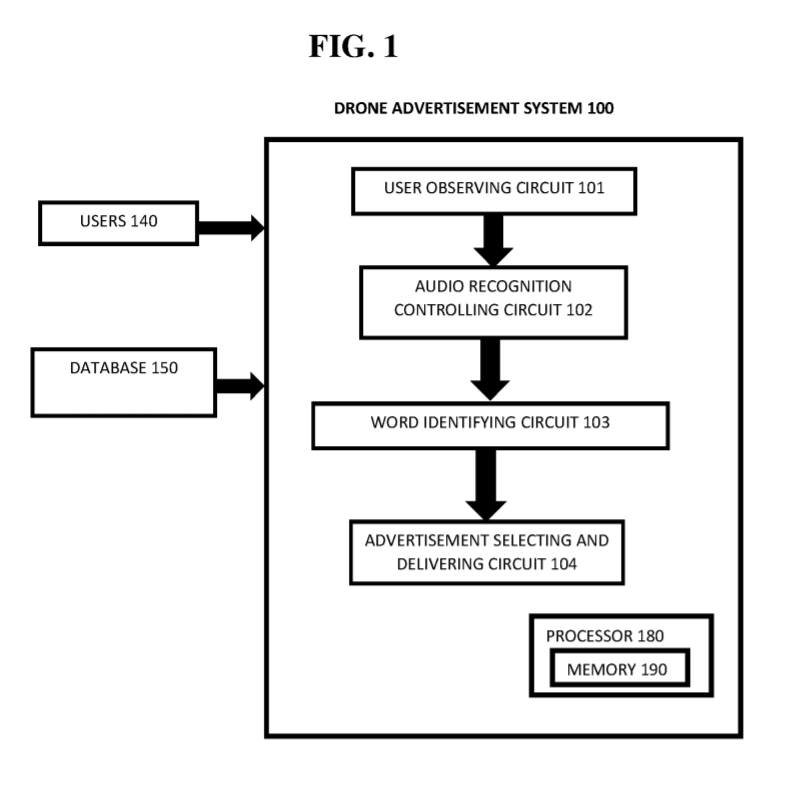 In terms of entities receiving patents issued by the U.S. Patent and Trademark Office, the last three decades have been dominated by Armonk, NY-based International Business Machines (IBM), an information technology giant that has ranked first among all U.S. patent recipients for each of the last 28 years. A quick search of the USPTO’s Full-Text Patent Database shows that IBM has earned another 8,308 patents through December 7 of this year, so while the R&D company only has a few weeks to match its total of 9,130 U.S. patents in 2020, it looks like IBM will again rank at the top of the listings for 2021’s U.S. patent recipients.
In terms of entities receiving patents issued by the U.S. Patent and Trademark Office, the last three decades have been dominated by Armonk, NY-based International Business Machines (IBM), an information technology giant that has ranked first among all U.S. patent recipients for each of the last 28 years. A quick search of the USPTO’s Full-Text Patent Database shows that IBM has earned another 8,308 patents through December 7 of this year, so while the R&D company only has a few weeks to match its total of 9,130 U.S. patents in 2020, it looks like IBM will again rank at the top of the listings for 2021’s U.S. patent recipients.
IBM engages in a vast array of research related to quantum computing, artificial intelligence and data communications, but the fixed-wing aircraft advertisement system of the ‘828 patent is perhaps the most eye-catching technology of the bunch. The patent claims a fixed-wing aircraft interacting with a cloud computing environment server which communicates with a cloud on-demand server that generates advertisements based on samples of speech heard via a microphone on the aircraft. The system further includes a camera on the aircraft that can detect facial landmark features without observing a person’s identity. The claimed invention is intended to deliver personalized advertising to a geo-localized audience based upon a sampling of what the aircraft’s microphone hears upon approaching a location.
The patent diagrams attached to the ‘828 patent seem to indicate that the fixed-wing aircraft contemplated for this system are smaller drones. While the ‘828 patent’s specification discusses how the claimed system reduces security concerns associated with typical targeted advertising systems that rely on collecting personal data, it’s not guaranteed that most people would feel a greater degree of privacy when seeing a conversation that was meant to be private turn into an ad on a passerby drone.
#2: U.S. Patent Application No. 20210228707, Coronavirus RNA Vaccines
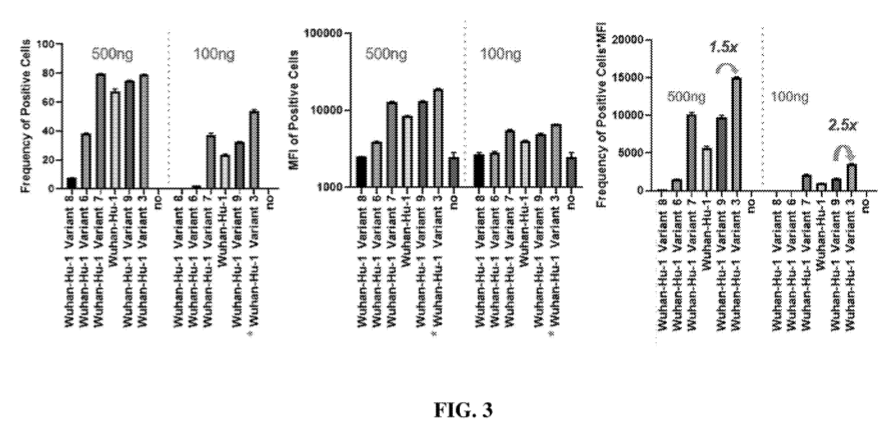 Although the ‘707 patent application, which was first filed with the USPTO in August 2020, has not resulted in the issue of a U.S. patent grant, the filing represents one of the most important patent stories of 2021. Filed by ModernaTX of Cambridge, MA, the patent application covers a messenger ribonucleic acid (mRNA) having at least 80 percent identity to a particular nucleotide sequence and encodes a polypeptide comprising a particular amino acid sequence. The claimed mRNA vaccine encodes highly immunogenic antigens that elicit potent neutralizing antibodies against coronavirus antigens, which “surprisingly” share less than 80 percent identity with the antigen sequences of Severe Acute Respiratory Syndrome (SARS), another disease caused by a strain of coronavirus.
Although the ‘707 patent application, which was first filed with the USPTO in August 2020, has not resulted in the issue of a U.S. patent grant, the filing represents one of the most important patent stories of 2021. Filed by ModernaTX of Cambridge, MA, the patent application covers a messenger ribonucleic acid (mRNA) having at least 80 percent identity to a particular nucleotide sequence and encodes a polypeptide comprising a particular amino acid sequence. The claimed mRNA vaccine encodes highly immunogenic antigens that elicit potent neutralizing antibodies against coronavirus antigens, which “surprisingly” share less than 80 percent identity with the antigen sequences of Severe Acute Respiratory Syndrome (SARS), another disease caused by a strain of coronavirus.
This filing is important not only for the COVID-19 vaccine technology that it covers but also because of the legal battle that has been shaping up over inventorship to the claimed subject matter of the patent application. The ‘707 patent application is at the center of a dispute between Moderna and the National Institutes of Health, which alleges that its scientific researchers contributed to the development of the mRNA claimed in the patent application. In late July, Moderna filed a statement with the USPTO pursuant to duty to disclose requirements stating in part that “[Moderna has] reached the good-faith determination that [the NIH researchers] did not co-invent the mRNAs and mRNA compositions claimed in the present application.”
#3: U.S. Patent No. 11089262, Virtual Eye Contact in Video Interaction
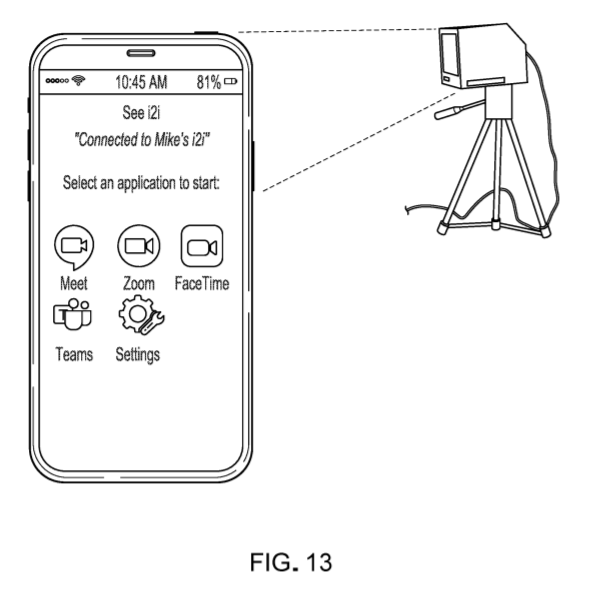 One of the indelible marks left on our society by the COVID-19 pandemic has been a massive shift towards video conferencing technologies. While Zoom was a well-known company before the pandemic, the economic shutdowns and social distancing orders of the past nearly two years have turned that company into a household name. Among law school students, the Zoom School of Law meme turned from a joke into an opportunity to raise about $50,000 for nonprofit charities.
One of the indelible marks left on our society by the COVID-19 pandemic has been a massive shift towards video conferencing technologies. While Zoom was a well-known company before the pandemic, the economic shutdowns and social distancing orders of the past nearly two years have turned that company into a household name. Among law school students, the Zoom School of Law meme turned from a joke into an opportunity to raise about $50,000 for nonprofit charities.
The ‘262 patent, issued in November to Australian-based See I2I Pty. Ltd., addresses one of the more unnerving aspects of online video conferencing, namely the inability of participants to maintain eye contact based on the different positions of the camera and video display on their computers. It claims an apparatus with a beam splitter with an optical lens mounted to face the splitter’s rear surface, a video display facing the splitter’s front surface, and a mechanism associated with the splitter and the video display structured to enable either open or closed configurations, the open configuration enabling a reflection of the video display to be visible from a location facing the splitter’s front surface. The claimed apparatus is capable of capturing videos of a user’s eyes along either a video capture axis or a display axis, which are aligned by executable instructions in such a way that maintains eye contact between users in a live video interaction session.
#4: U.S. Patent No. 10938854, Systems and Methods for Preventive Ransomware Detection Using Honeypots
 The first half of 2021 unfortunately saw a series of successful cyber attacks that shut down Colonial Pipeline, meatpacking firm JBS USA and several other major companies, crippling critical areas of U.S. infrastructure. A study of ransomware attacks issued this August by analytics firm Cognyte, formerly Verint Systems, found that 1,097 organizations worldwide experienced ransomware attacks during the first half of 2021, an increase of 100 percent over the first half of 2020. Thirty percent of all ransomware attacks focused on manufacturing entities, which are already strained by supply chain issues caused by the COVID-19 pandemic.
The first half of 2021 unfortunately saw a series of successful cyber attacks that shut down Colonial Pipeline, meatpacking firm JBS USA and several other major companies, crippling critical areas of U.S. infrastructure. A study of ransomware attacks issued this August by analytics firm Cognyte, formerly Verint Systems, found that 1,097 organizations worldwide experienced ransomware attacks during the first half of 2021, an increase of 100 percent over the first half of 2020. Thirty percent of all ransomware attacks focused on manufacturing entities, which are already strained by supply chain issues caused by the COVID-19 pandemic.
The ‘854 patent, issued to Swiss computer security firm Acronis International GmbH, claims a novel method for detecting ransomware and malicious programs using file honeypots, computer security mechanisms that appear to cyberattackers to be legitimate parts of a computer network but are designed to detect and report on malicious network activity. The method involves generating a file honeypot in a filesystem directory, receiving a directory enumeration request from a process executing in an operating system environment, determining whether that process is a trusted process based on characteristics like fingerprint or process identifier, providing the file list including the honeypot to the process if it is not identified as trusted, intercepting a file modification request for the honeypot from the process, and identifying that process as suspicious responsive to intercepting the file modification request. The claimed method is designed to improve upon previous approaches for protecting computer systems against ransomware like backing up an entire hard drive or creating file snapshots, either of which can be very costly and time consuming to accomplish.
#5: U.S. Patent No. 11030607, System and Method for Facilitating Electronic Financial Transactions During a Phone Call
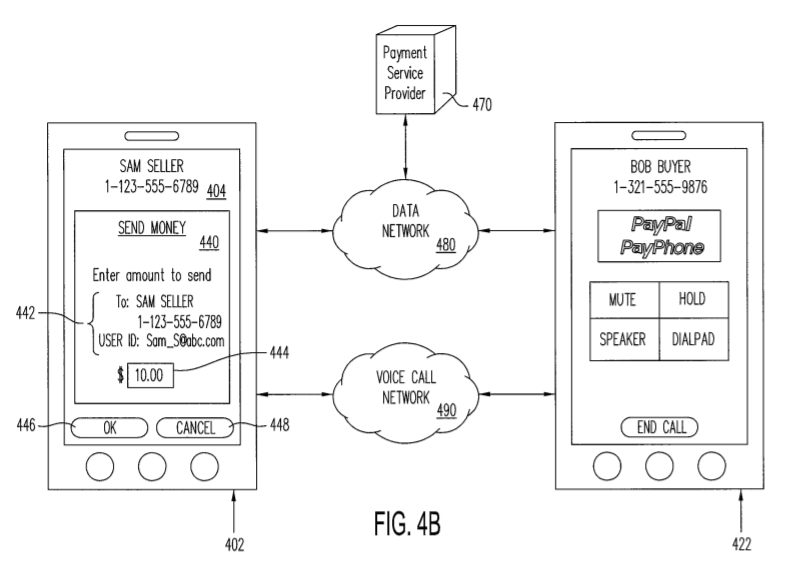 The fintech revolution has greatly increased the number of ways in which consumers across the globe can pay for the goods and services they need thanks in large part to peer-to-peer payment apps operating over mobile networks and the Internet. App industry analysis website Business of Apps reports that the mobile payment app Venmo has grown from 10 million users in 2017 up to 52 million users in 2020; during that same period of time, payment volume through Venmo increased from $34 billion USD up to $159 billion USD. Likewise, online statistics portal Statista reports that the net volume of payments through PayPal during 2021’s second quarter was $311 billion USD, a 41 percent increase over the same period in 2020.
The fintech revolution has greatly increased the number of ways in which consumers across the globe can pay for the goods and services they need thanks in large part to peer-to-peer payment apps operating over mobile networks and the Internet. App industry analysis website Business of Apps reports that the mobile payment app Venmo has grown from 10 million users in 2017 up to 52 million users in 2020; during that same period of time, payment volume through Venmo increased from $34 billion USD up to $159 billion USD. Likewise, online statistics portal Statista reports that the net volume of payments through PayPal during 2021’s second quarter was $311 billion USD, a 41 percent increase over the same period in 2020.
This June, San Jose, CA-based PayPal was issued the ‘607 patent, which claims a system of an electronic services provider including a hardware processor executing instructions stored on non-transitory memory to access a voice communication session between two mobile users, detect an activation command triggered by an engagement of an interactive virtual mechanism on one device that requests the activation of a payment handler on the other device, cause the payment handler to display a transaction request, detect an engagement of the payment handler and process the transaction request based on the detected engagement. The resulting invention is designed to integrate transaction systems during phone calls to increase the ease of transactions for food delivery orders or for transactions among non-merchants (i.e.: friends and family).
#6: U.S. Patent No. 10943268, Paying for Content Through Mining
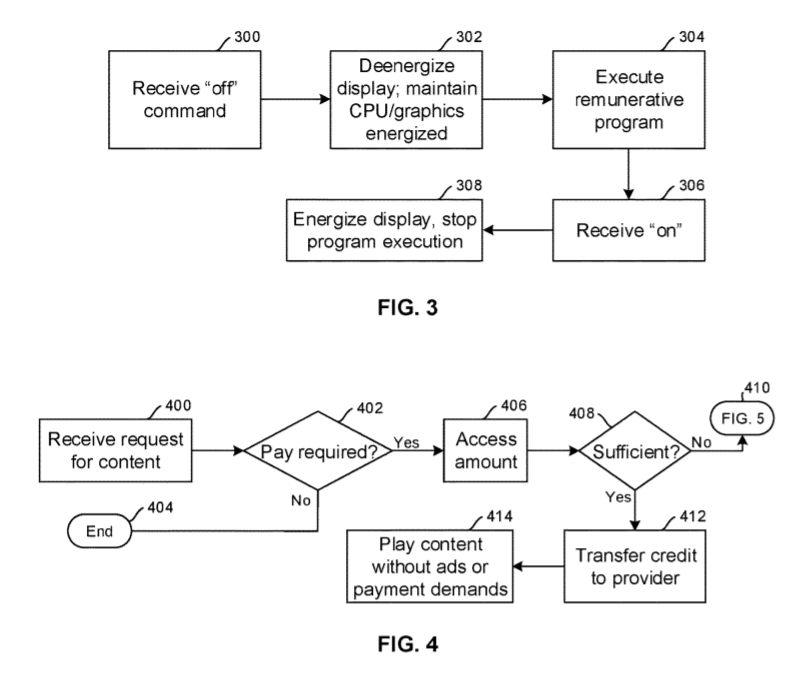 Although the tremendous volatility in the price of cryptocurrencies continues to keep many institutional investors wary, Bitcoin reached record highs during 2021 and the decentralized digital currency is not going away any day soon. One of the limiting factors on the usefulness of Bitcoin in daily transactions is the incredibly high cost of mining, the process of creating new Bitcoin units or entering new transactions onto the blockchain. The current advanced state of the Bitcoin blockchain requires incredibly complex mathematical computations to be solved in order to enter new transactions.
Although the tremendous volatility in the price of cryptocurrencies continues to keep many institutional investors wary, Bitcoin reached record highs during 2021 and the decentralized digital currency is not going away any day soon. One of the limiting factors on the usefulness of Bitcoin in daily transactions is the incredibly high cost of mining, the process of creating new Bitcoin units or entering new transactions onto the blockchain. The current advanced state of the Bitcoin blockchain requires incredibly complex mathematical computations to be solved in order to enter new transactions.
Issued this March to Japanese tech conglomerate Sony Corporation, the ‘268 patent claims a method of leveraging the energized components of a device while the display is off to perform Bitcoin mining tasks in the background in exchange for remuneration credited to an account. The method involves identifying an application either pre-installed or downloadable to a game console or display device, executing the application to remunerate a user account for the use of the console or device’s processing power when no game or content is being displayed, and paying for games or content using in part credit acquired by executing the application. The resulting invention is designed to enable users to obtain games or content without being forced to view advertisements. Interesting, a search of the USPTO’s Public PAIR system shows that, while the ‘268 patent faced several rejections prior to issuance for obviousness, novelty and written description issues, it never faced a single Section 101 objection despite looking very much like the kind of payment systems that were declared patent-ineligible in recent cases such as Alice v. CLS Bank and Ultramercial v. Hulu.
#7: U.S. Patent No. 11151880, Systems and Methods for Providing Guidance to Vehicle Drivers Regarding Predicted Lane-Change Behavior of Other Vehicle Drivers
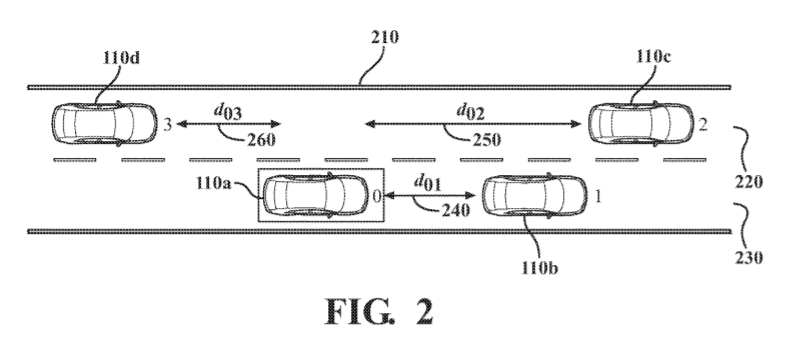 New vehicle models are being outfitted with so many new sensors and computing systems for improving various aspects of driving that it’s contributing to the global chip shortage which is costing the automotive industry billions of dollars due to production slowdowns. This August, the USPTO issued the ‘880 patent to Toyota Motor Engineering & Manufacturing North America, claiming a system for providing guidance to vehicle drivers regarding predicted lane-change behaviors of other vehicle drivers. The system includes instructions executable by a processor to transform historical vehicle trajectory data for a plurality of drivers, a clustering module grouping the drivers into a plurality of groups having similar driving behaviors, a Bayesian inference module training a Bayesian neural network for each driver in those groups, and a lane-change guidance module that identifies a particular driver, estimates a possibility that the driver will change lanes based on the Bayesian neural network trained for that driver, and communicates guidance on predicted lane-change behavior to vehicles within the vicinity. This machine learning system can help reduce frustration in those who get aggravated when nearby cars fail to signal a lane change.
New vehicle models are being outfitted with so many new sensors and computing systems for improving various aspects of driving that it’s contributing to the global chip shortage which is costing the automotive industry billions of dollars due to production slowdowns. This August, the USPTO issued the ‘880 patent to Toyota Motor Engineering & Manufacturing North America, claiming a system for providing guidance to vehicle drivers regarding predicted lane-change behaviors of other vehicle drivers. The system includes instructions executable by a processor to transform historical vehicle trajectory data for a plurality of drivers, a clustering module grouping the drivers into a plurality of groups having similar driving behaviors, a Bayesian inference module training a Bayesian neural network for each driver in those groups, and a lane-change guidance module that identifies a particular driver, estimates a possibility that the driver will change lanes based on the Bayesian neural network trained for that driver, and communicates guidance on predicted lane-change behavior to vehicles within the vicinity. This machine learning system can help reduce frustration in those who get aggravated when nearby cars fail to signal a lane change.
#8: U.S. Patent No. 11123560, Methods of Treating COVID-19 Induced Cytokine Storm
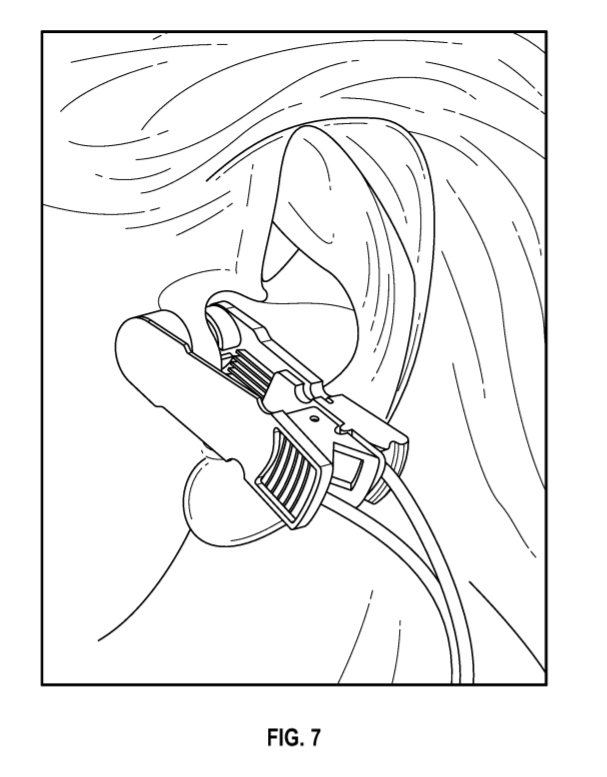 While Pfizer and Moderna have been two of the leading pharmaceutical companies in the fight against COVID-19, efforts to combat the effects of the pandemic have come from many corners of the innovation ecosystem. This June, the USPTO issued the ‘560 patent to independent inventor Patrick M. Nemechek of Buckeye, AZ, which is directed at a method for preventing, reducing or reversing cytokine storm, a severe immune system response caused by COVID-19 that can devastate tissues and organs within a patient suffering from the disease. The claimed method involves administering vagus nerve stimulation provided transcutaneously using electrical stimulation achieved by clipping electrodes across an area of the patient’s ear and inducing an electrical current with a transcutaneous electrical nerve stimulation unit. The stimulation is administered to a patient four times a day for five minutes each over the course of 14 days. Stimulation of the vagus nerve has been shown to reduce inflammation and continues to be studied for its potential in preventing the often fatal effects of COVID-19 induced cytokine storms.
While Pfizer and Moderna have been two of the leading pharmaceutical companies in the fight against COVID-19, efforts to combat the effects of the pandemic have come from many corners of the innovation ecosystem. This June, the USPTO issued the ‘560 patent to independent inventor Patrick M. Nemechek of Buckeye, AZ, which is directed at a method for preventing, reducing or reversing cytokine storm, a severe immune system response caused by COVID-19 that can devastate tissues and organs within a patient suffering from the disease. The claimed method involves administering vagus nerve stimulation provided transcutaneously using electrical stimulation achieved by clipping electrodes across an area of the patient’s ear and inducing an electrical current with a transcutaneous electrical nerve stimulation unit. The stimulation is administered to a patient four times a day for five minutes each over the course of 14 days. Stimulation of the vagus nerve has been shown to reduce inflammation and continues to be studied for its potential in preventing the often fatal effects of COVID-19 induced cytokine storms.
#9: U.S. Patent No. 10902431, Systems and Methods for Monitoring and Analyzing Financial Transactions on Public Distributed Ledgers for Suspicious and/or Criminal Activity
 Another issue that has created a lot of tension between cryptocurrencies and law enforcement agencies is the high degree of anonymity in transactions recorded on the blockchain, which have raised concerns that such platforms would be a boon for criminal activity. This January, the USPTO issued the ‘431 patent to identity verification firm Jumio Corporation of Palo Alto, CA, claiming a system for monitoring financial transactions involving cryptocurrencies for suspected criminal behavior. The system includes hardware processors executing instructions to obtain information on transactions recorded on public distributed ledgers, correlate public third-party information with transaction addresses, label the addresses and transactions according to characteristics, cluster the transactions and assign a level of risk regarding suspicious and/or criminal activity to the transactions and addresses.
Another issue that has created a lot of tension between cryptocurrencies and law enforcement agencies is the high degree of anonymity in transactions recorded on the blockchain, which have raised concerns that such platforms would be a boon for criminal activity. This January, the USPTO issued the ‘431 patent to identity verification firm Jumio Corporation of Palo Alto, CA, claiming a system for monitoring financial transactions involving cryptocurrencies for suspected criminal behavior. The system includes hardware processors executing instructions to obtain information on transactions recorded on public distributed ledgers, correlate public third-party information with transaction addresses, label the addresses and transactions according to characteristics, cluster the transactions and assign a level of risk regarding suspicious and/or criminal activity to the transactions and addresses.
#10: U.S. Patent No. 11138237, Social Media Toxicity Analysis
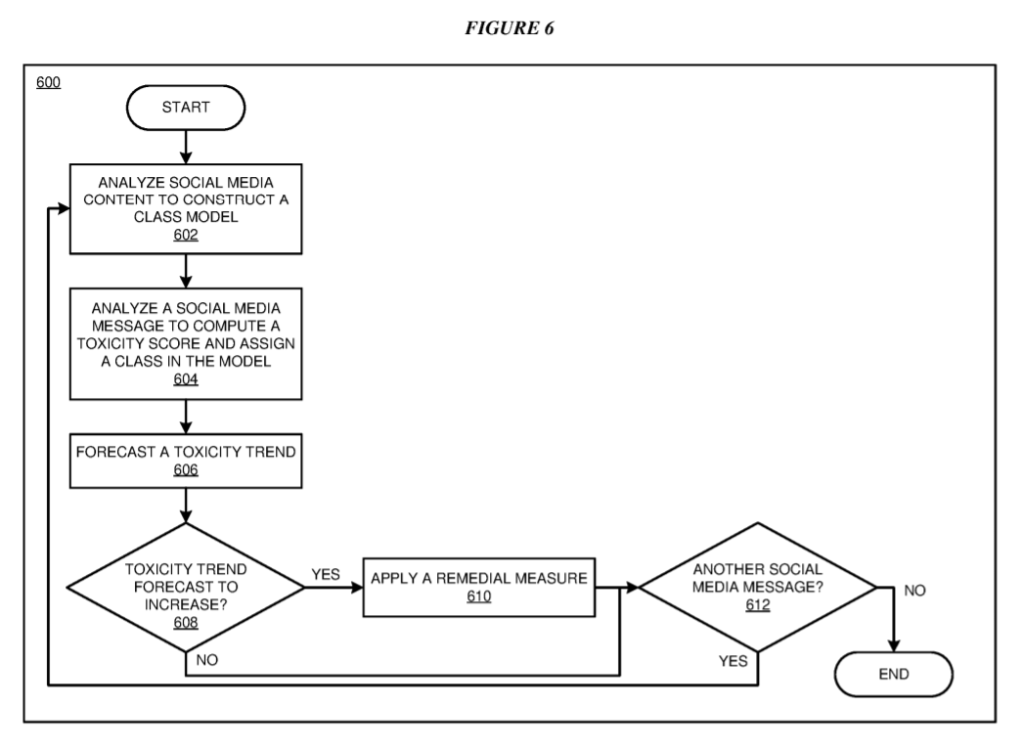 The 2010s saw social media networking evolve from a neat way to stay connected with friends at school into an anxiety-ridden information superhighway exposing us to way too many instantaneous thoughts from our friends and family members. With its second entry on our Top 10 Patents list, IBM was issued the ‘237 patent from the USPTO in early October. It claims a method of constructing from social media content a class model representative of a type and level of toxicity associated with the content based upon the topic of the content, a sentiment score assigned to an interaction involving the content, and an elapsed time between first and second messages in the content. The toxicity level determined using this method is a measure of the probability that the interaction will cause another participant to disengage. The resulting invention is designed to address various shortcomings in previous methods employed to reduce toxicity in online social interactions, including the use of human moderators and systems for user reporting of bad behavior.
The 2010s saw social media networking evolve from a neat way to stay connected with friends at school into an anxiety-ridden information superhighway exposing us to way too many instantaneous thoughts from our friends and family members. With its second entry on our Top 10 Patents list, IBM was issued the ‘237 patent from the USPTO in early October. It claims a method of constructing from social media content a class model representative of a type and level of toxicity associated with the content based upon the topic of the content, a sentiment score assigned to an interaction involving the content, and an elapsed time between first and second messages in the content. The toxicity level determined using this method is a measure of the probability that the interaction will cause another participant to disengage. The resulting invention is designed to address various shortcomings in previous methods employed to reduce toxicity in online social interactions, including the use of human moderators and systems for user reporting of bad behavior.

![[IPWatchdog Logo]](https://ipwatchdog.com/wp-content/themes/IPWatchdog%20-%202023/assets/images/temp/logo-small@2x.png)

![[Advertisement]](https://ipwatchdog.com/wp-content/uploads/2024/04/Artificial-Intelligence-2024-REPLAY-sidebar-700x500-corrected.jpg)
![[Advertisement]](https://ipwatchdog.com/wp-content/uploads/2024/04/Patent-Litigation-Masters-2024-sidebar-700x500-1.jpg)

![[Advertisement]](https://ipwatchdog.com/wp-content/uploads/2021/12/WEBINAR-336-x-280-px.png)
![[Advertisement]](https://ipwatchdog.com/wp-content/uploads/2021/12/2021-Patent-Practice-on-Demand-recorded-Feb-2021-336-x-280.jpg)
![[Advertisement]](https://ipwatchdog.com/wp-content/uploads/2021/12/Ad-4-The-Invent-Patent-System™.png)






Join the Discussion
7 comments so far.
Greg DeLassus
December 30, 2021 07:08 pmI am skeptical how much business value the above ModeRNA patent application actually has. First, the only novel aspect of this application relative to their own prior art (WO 15/164674) is the sequence of the SARS-CoV2 spike protein, which was already published as of their filing date. That makes for a tough obviousness rejection, commercial success notwithstanding.
Second, their more robustly enforceable IP (US 10,022,435) runs until 2035. Who cares if the above, more recent application never grants? Who expects still to be marketing this generation of COVID19 vaccines in 2035?
Tuanon
December 30, 2021 08:23 amTo add to Greg’s comment, and with a bit of irony, the strongest patent on validity and the one having the most business value on this list is probably the future patent resulting from the Moderna application. Claims narrowed to the protein sequence with wiggle scope for the codons, and a marketed drug (if this is the one on the market): what’s not to like?
Anon
December 30, 2021 07:34 amI find myself seeing yet another post from Mr. DeLassus that only leads me to lower my expectations of his views.
Frankly, jumping to a position damming ALL of the items against (unspecified) validity challenges — without more — is an especially empty opinion.
Greg DeLassus
December 29, 2021 06:07 pmI doubt that any of these patents will hold up against a validity challenge if asserted. I agree that they all reflect interesting technologies, but considered as patents they seem a distinctly unimpressive bunch.
Anonymous
December 29, 2021 04:19 pmGene, I’m also interested in seeing the number of comments an article has generated before I click into an article.
Second, removing some numbering system makes it difficult to track and understand historical threads. If a thread had 80 comments, and the 75th replies to the 44th and 15th comments, it is nearly impossible to track, diminishing the collective value of the site. Please re-visit that feature.
Anon
December 29, 2021 04:00 pmI would add to Mr. Jedor’s comments that one of the downfalls to comments (in general) is a lack of ability to make those with competing viewpoints Engage on the merits.
The editorial controls here were much better than other blogs in that a nice balance was struck between what I term John Maynard Keynes treatment and mindless invective. Also, those who wantonly would post with false ‘views’ were given a very short leash, and blocked as deserved, which helped remove those who would choose to persist in uninformed opinionating.
I would prefer formatting (and editorial controls) that Promoted meaningful interactions rather than diminish them.
Lab Jedor
December 29, 2021 01:28 pmNice summary Steve and an interesting read.
Now off-topic:
I agree with Anon about the New Format. It provides a modern image, but personally I find it difficult to manage/follow for comments. I find the Comment sections of the Articles as important as the Articles themselves. It creates a sense of community wherein different points of view are represented. By providing the number of Comments one can see which topics are of special interest to Readers (anything related to 101/Alice issues is high on the list). Also, numbering the comments provides a useful reference point for facilitating a thread, rather than looking like stand-alone loose Comments.
It appears (but that may be unintentional) that the new format was introduced to promote the Articles and Authors rather than the Comments and the Commenters. IPWatchDog is a business and I assume that some thoughts and research went into the change. Including probably calculating into the change unhappiness with the new format by the “old geezers” that comment on a regular basis. The new format makes for now IPWatchDog overall less interesting for me than the old format.
I believe IPWatchDog and the IP community have been extremely fortunate to have so many regular and incidental commenters on a wide range of IP subjects, all reasonably informed on the subject matter and enable to articulate their often competing views, in an overall reasonably respectful tone. (well, perhaps not always).
I will follow Anon’s lead and wait if the new format grows on me. IPWatchDog deserves that loyalty. But what the heck, the old readers of the old format, like independent inventors like me pursuing a patent, may be a dying breed anyway.